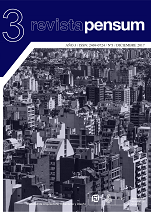ARCHITECTURE AND WRITING ABOUT THE QUESTION, WHY IS WRITING PART OF ARCHITECTURAL WORK?
DOI:
https://doi.org/10.59047/2469.0724.v3.n3.19013Keywords:
Writing, Architecture, Legitimacy, CritiqueAbstract
Recent texts which were published by architects of Córdoba allow for a reflection on the relationship between writing and architecture. In the first place, this article offers an hermeneutical reconstruction of both terms, and it finds in the signifier “text” a point of departure for their relationship. After this, three historically influential models of writing about architecture are identified: classicist deontologism, pragmatic deontologism and critical tradition. Following the analysis of the structure and leading ideas of each one of them, the most meaningful transversal issues are identified: modernity, city, pedagogy esthetics and subjectivity. These issues represent at the same time a reception and an attempt at overcoming the models exposedReferences
Apel, K.-O. (1986) Estudios éticos, Alfa, Barcelona.
Arango, S. (2004) “Espacios públicos recientes en América Latina”, 30-60. Cuaderno latinoamericano de arquitectura, 1, 24-29
Castells, M. (1995) La ciudad informacional, Alianza, Madrid.
Deleuze, G. (1995) “Post-scriptum sobre las sociedades de control”, en Conversaciones, Pre-Textos, Valencia, 277-286.
Donzelot, J. (1991) “Espacio cerrado, trabajo y moralización”, en M. Foucault et al. Espacios de poder, Ediciones de la piqueta, Madrid.
Dutari, I. (comp.) (2006) N4 Formación en Proyecto, FAUDI-UNC, Córdoba.
Fernández, R. (2017) Selva oscura o en qué acaba lo moderno, Córdoba: UNC-FAUD.
Fernández Castro, J. (2017) “Urbano/mestizo/compacto/múltiple/justo”, en S.I. Dutari et al., Pensar la vivienda, vivir la ciudad, UNC-FAUD, Córdoba, 48-53.
Foucault, M. (1986) Historia de la locura en la época clásica I, FCE, México.
Gadamer, H.-G. (1994) Verdad y método, Sígueme, Salamanca.
García Vázquez, M. de L. (2017) “Habitar el diseño: la vivienda desde la igualdad de género”, en S.I. Dutari et al., Pensar la vivienda, vivir la ciudad, UNC-FAUD, Córdoba, 54-58.
Gombrich, E.H. (2008) Historia del arte, Phaidon Press, Barcelona.
Harvey, D. (2012) Rebel Cities, Verso, London/New York.
Heidegger, M. (1994), “Construir, habitar, pensar”, en Conferencias y artículos, Ediciones del Serbal, Barcelona.
Lethaby, W.R. (1939) Architecture. An Introduction to the History and Theory of the Art of Building, Thornton Butterworth, London.
Levinas, E. (1995) Totalidad e Infinito, Sígueme, Salamanca.
Martiarena, M.; Re, G.; Eynard, C. (2012) Valoración subjetiva del paisaje por atractores, EDUCC, Córdoba.
Moiso, E. (2017) “Pensar la ciudad, vivir la región”, en S.I. Dutari et al., Pensar la vivienda, vivir la ciudad”, FAUD-UNC, Córdoba, 43-45.
Períes, L.; Ojeda, B.; Kesman, C.; Perazzolo, D. (2012) Catálogo del Paisaje del Río Suquía en la Ciudad de Córdoba 1, EDUCC, Córdoba.
Pokorny, J. (1959) Indogermanisches Etymologisches Wörterbuch, Francke, Bern/München.
Ruskin, J. The Seven Lamps of Architecture, Dana Estes, Boston.
Sargiotti, R. (2016) “Del Tratado de Indias a la Aldea Global”, en S.I. Dutari et al., Pensar la vivienda, vivir la ciudad, UNC-FAUD, Córdoba, 59-63.
Simmel, G. (1903) “Die Grosstädte und das Geistesleben”, en Th. Petermann (ed.) Die Grossstadt. Vorträge und Aufsätze zur Städteausstellung, Jahrbuch der Gehe-Stiftung, Dresden, 9, 185-206.
Vaan, M. de (2008) Etymological Dictionary of the Latin and the Other Italic Languages, Brill: Leiden/Boston.
Valéry, P. (1978) Eupalinos ou l´architecte, Sierra Madre, Monterrey.
Downloads
Published
Issue
Section
License
Authors who publish in this journal agree to the following terms:
a. Authors retain copyright and guarantee to the journal the right to be the first publication of the work as well as licensed under a Creative Commons Attribution-ShareAlike 4 license.
b. Authors may separately establish additional agreements for non-exclusive distribution of the version of the work published in the journal (e.g., placing it in an institutional repository or publishing it in a book), with an acknowledgement of its initial publication in this journal.
c. Authors are permitted and encouraged to disseminate their work electronically (e.g., in institutional repositories or on their own website) before and during the submission process, as this may result in productive exchanges, as well as earlier and greater citation of published work (See The Effect of Open Access).
d. 4.0 International Creative Commons Attribution-ShareAlike 4.0 License.












